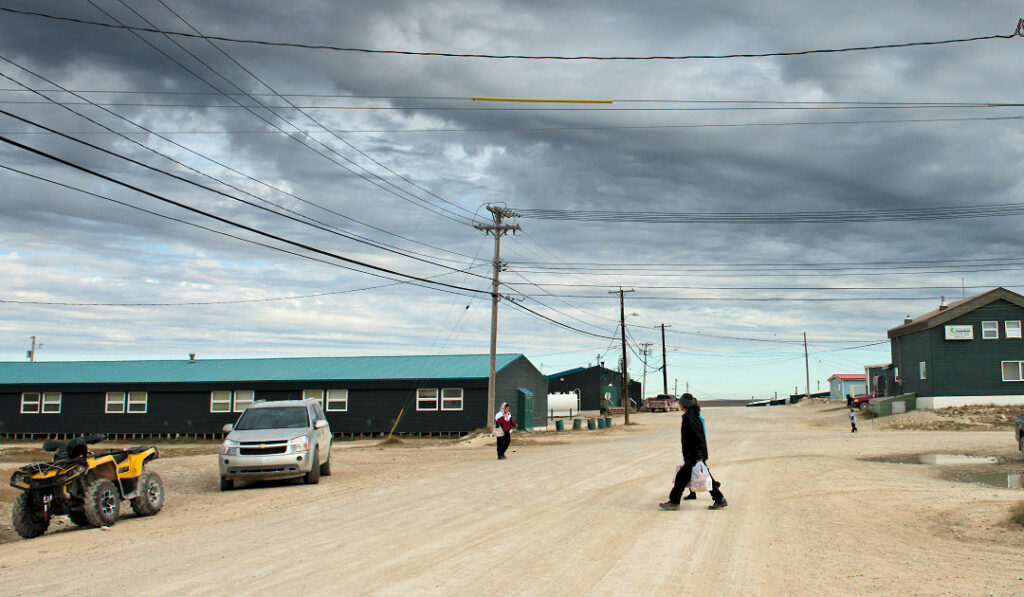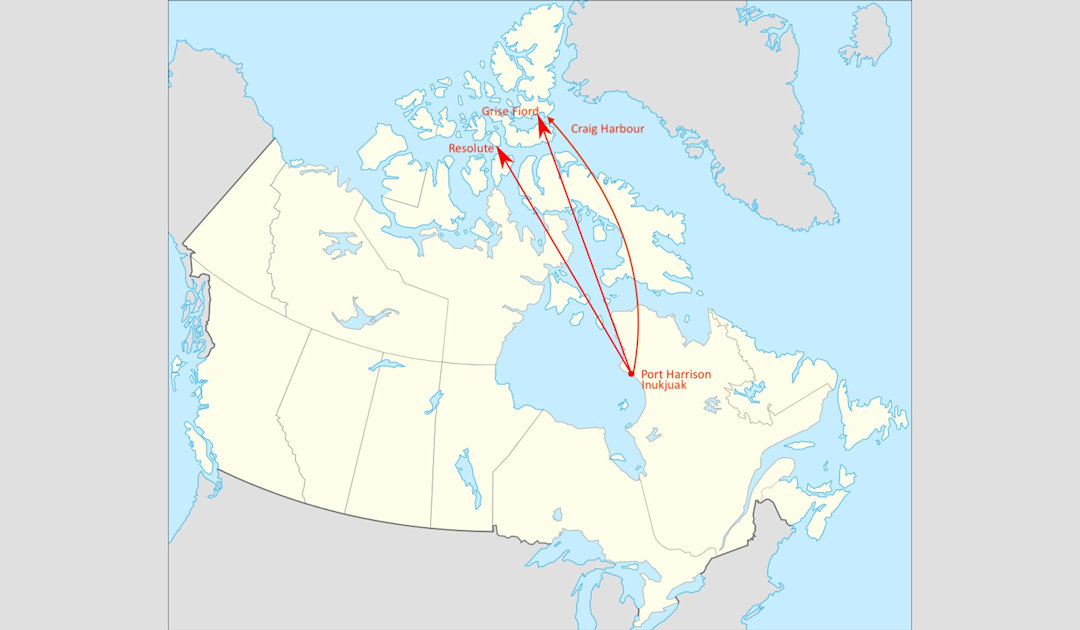
On the occasion of the Ever Deadly documentary release, PolarJournal author Mirjana Binggeli comes back to one of the most innovative contemporary artists. Between artistic achievements, musical experimentation and activism, the portrait of a sublime and uncompromising artist, who inscribes her art in a thousand-year-old practice and a difficult contemporary history.
She stands barefoot at the center of the stage, looking at the public, a smile on her face. In an almost childish way, she greets the audience with a wave of her hand. Then she brings the microphone to her lips and begins to sing. Her name is Tanya Tagaq and nothing has prepared you for what is about to come.
We are in 2015 when Tagaq delivers this mind-blowing performance during a TED talk. For nearly eight minutes, a cappella, she shows the full extent of her talent: mastering the stage, she manages to keep the audience and viewers spellbound, hanging on this voice which oscillates between caressing softness and powerful roars, alternating at the same time high and low sounds. Tanya Tagaq is an Inuit singer. A true spearhead to the revival of the genre, she has projected Inuit throat singing, the katajjaq, straight into the 21st century, giving it a new artistic dimension hitherto unseen.
A song as a game
The practice of katajjaq goes back over millennia and very little is known about it. The first written mention that we find comes from a testimony by the American polar explorer, Robert E. Peary, at the very end of the 19th century.
Sung exclusively by women, it is thought to have been invented by them to keep themselves busy and entertained when men went hunting.
A practice prohibited during the colonial period, there’s been a strong revival of this practice in recent decades, the katajjaq having become a strong identity trait, truly specific to the Inuit who defend it against any form of appropriation.
Indeed, the katajjaq is a throat song specific to the Inuit of Canada. It even differs from other forms of throat singing practiced in the Arctic, such as the Chukchi’s pic eynen or the Ainu’s rekutkar. The latter are indeed distinguished from their Inuit cousin by their use of singing in the context of rituals or celebrations.
However, in its traditional form, the katajjaq, is more than a song. It is a game. Practiced in duos and only by women, it alternates inspired and expired sounds consisting of onomatopoeia or words. The themes are often inspired by familiar sounds, such as noises emitted by animals or the environment (the sound produced by the mosquitoes’ flight or the ice cracking) and by everyday noises, such as, for example, the rattling of dishes being washed.
Thus, if katajjaq is a game, how is it played ?
Two women stand face to face, very close, holding each other by the hands, sometimes by the arms or by the shoulders. The first singer (or player) gives the low sound and the second the high sound, but out of phase, as in a canon. The combination of these two sounds, associated with a rhythm, will produce a kind of a pattern which will be repeated until one of the singers decides to modify the pattern which will be then repeated and so on. The game ends when one of the two singers comes out of breath or, what happens more often, bursts into laughter, making the other singer the winner of this vocal contest.
The katajjaq requires great vocal endurance, excellent breath control and a lot of experience. Indeed, it is not enough to just have a little technique to perform this. To win, the singers must also be able to produce beautiful sounds and sing in perfect unison with each other, a harmonious interlacing of voices that respond to each other to the point that it becomes impossible for the listener to distinguish which sound belongs to whom.
Knowing the katajjaq’s history, we can measure how much Tanya Tagaq has revolutionized the genre.

Singer, writer, director and activist
Born in Iqaluktuuttiaq (formerly Cambridge Bay) in Nunavut, in 1975, Tanya Tagag Gillis began to learn throat singing thanks to a cassette that her mother gave her. She was then a student at the Nova Scotia College of Arts, and had no one to sing the katajjaq with. She will therefore practice alone, building the foundations of what will make her artistic singularity.
In 2004, she became internationally known by collaborating with the Icelandic singer, Björk, on her album Medùlla. The following year, Tagaq released her debut album, Sinaa, and began to make a name for herself at folk music festivals.
And it is true that this young woman is an amazing stage performer since she seems to capture all the energies from the cosmos to pour them on an audience who begs for more. Tagaq’s stage performances are so powerful and inhabited that the singer herself has confided that she had more than once had “the feeling of leaving her body”.
A multifaceted artist, Tagaq has already released five studio albums (the last one, the excellent Tongues, was released in 2022), an EP, a live album and a book, Split Tooth, published in 2018, that has received a wide critical acclaim.
She is often described as a punk artist, which is surprising since Tagaq seems to pulverize all genres, offering to hear an astonishing plasticity of throat singing that seems to adapt and transcend any type of music. As proof, her collaborations with other artists. From the Toronto Symphony Orchestra to the indie pop group Weaves and including the Kronos Quartet, the Inuit singer adds her voice as an evidence, to the point that we wonder why no one has thought about it before.
And Tanya Tagaq is now back with a documentary, Ever Deadly (translated in French as Sound Hunter), co-directed with Chelsea McMullan. Premiering last fall at the Toronto International Film Festival, it was released yesterday in Canadian theaters and should be available on the Internet after having toured in Canada.
Described as an immersive and visceral sound and visual experience, Ever Deadly is a dive into Tagaq’s life and work, but also into her story and that of her family. It is also an opportunity for us to discover her activist work for Indigenous women and Inuit.
“My daughters and I are four times more likely to be murdered than other people’s daughters. I don’t feel like there should be that huge of a discrepancy based on race,” she declared after winning the Polaris Music Prize in 2015.
Constantly recalling that the number of Indigenous women who are missing or have been murdered amounts to a frightening 1,200 individuals, Tanya Tagaq, using her notoriety, highlights a story too little told, that of Western colonial policy towards Indigenous populations, especially in the Arctic. And devastating consequences still very much alive today.
A revolt that finds its roots in Tanya Tagaq’s personal history and, in particular that of her mother, Mary, moved to Resolute when she was a child.

A place with no dawn
We are in the 1950s. The Cold War has just emerged from Second World War’s rubble and already begins the geostrategic and political confrontations which, for nearly 40 years, will divide the world in two. The Arctic is no exception to the rule: colossal stakes for both blocs are contained in this region, particularly in terms of territorial appropriation for geopolitical purposes.
The 1950s also saw the massive start of a policy of assimilation of Inuit and Arctic native populations, that often went hand in hand with the sedentarization of these populations.
At the same time, the economical collapse of the Inuit populations of the Hudson Bay region plunged those people into precariousness after skins and furs price have dropped. The Hudson’s Bay Company of Port Harrison (now Inukjuak) alerted the Canadian government, asking the latter to set up food and social aid for the most affected populations.
This request for help is a godsend for the government, an opportunity to claim the sovereignty of Arctic territories by settling Canadian citizens there. Thus the authorities will decide to relocate, between 1953 and 1955, the 19 families constituting the Inuit population of Hudson Bay to the Canadian High Arctic, in the newly created villages of Resolute, Grise Fiord and Craig Harbor. In Inuktitut, Resolute and Grise Fiord are called Qausuittuq and Aujuittuq, in other words a place with no dawn and a place that never thaws…


These populations’ displacement will be catastrophic. Used to a rather subarctic climate, these men and women find themselves, after a month of boat trip in the ice, immersed in one of the most hostile environments there is. In emergency, they must improvise themselves as seal and polar bear hunters, in an endless and freezing polar night where temperatures can plunge to -50°C. On several occasions, they will be close to starvation, without understanding why they have been abandoned in this inhospitable region, without resources and without homes; the first permanent dwellings were only built in 1962 by the authorities.
It is at the cost of dantesque efforts that these populations will finally manage to survive and settle in these remote regions. The villages of Resolute and Grise Fiord still exist and are respectively populated by 183 and 144 inhabitants.
Magician of sound
The documentary Ever Deadly also talks about this story, barely known in our latitudes and yet essential to be told.
Tanya Tagaq, in her own way, has opened a door on Inuit culture and history, while developing a unique artistic approach, characterized by a great strength of interpretation that never leaves indifferent and often disconcerts.
At the beginning of Ever Deadly trailer, there is this moment when Tanya Tagaq addresses the audience before starting her set. In that soft spoken voice of hers, she playfully says: “It’s a very small room. So, if you really hate it, it’s easy to leave.” She bursts into laughter with the audience, an audience determined not to leave the room and to listen to a song coming from the depths of the Arctic, carried by a magician of sound, sincere and passionate, that nothing seems to stop.
Mirjana Binggeli, PolarJournal





